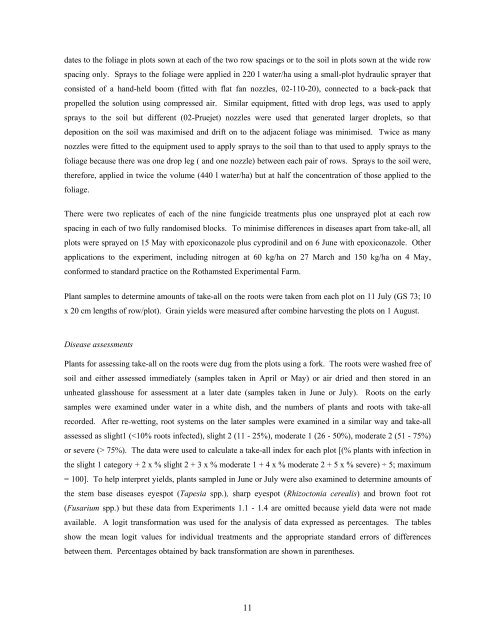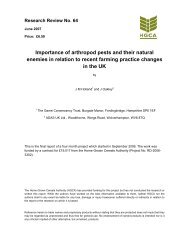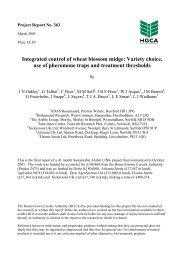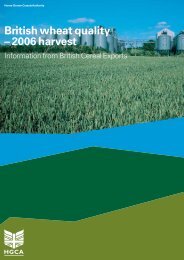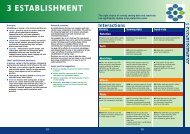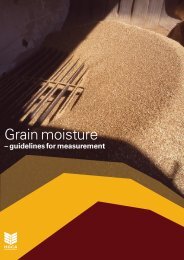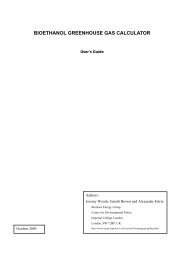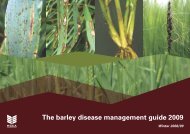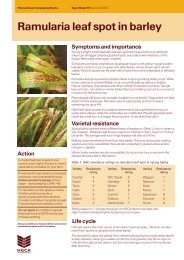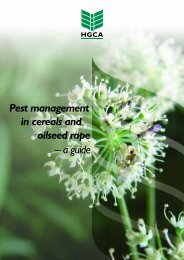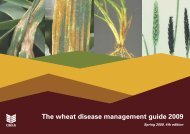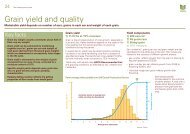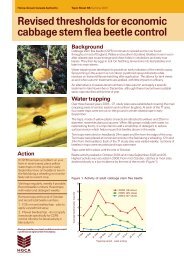PROJECT REPORT No. 285 EFFECTS OF ... - HGCA
PROJECT REPORT No. 285 EFFECTS OF ... - HGCA
PROJECT REPORT No. 285 EFFECTS OF ... - HGCA
- No tags were found...
Create successful ePaper yourself
Turn your PDF publications into a flip-book with our unique Google optimized e-Paper software.
dates to the foliage in plots sown at each of the two row spacings or to the soil in plots sown at the wide rowspacing only. Sprays to the foliage were applied in 220 l water/ha using a small-plot hydraulic sprayer thatconsisted of a hand-held boom (fitted with flat fan nozzles, 02-110-20), connected to a back-pack thatpropelled the solution using compressed air. Similar equipment, fitted with drop legs, was used to applysprays to the soil but different (02-Pruejet) nozzles were used that generated larger droplets, so thatdeposition on the soil was maximised and drift on to the adjacent foliage was minimised. Twice as manynozzles were fitted to the equipment used to apply sprays to the soil than to that used to apply sprays to thefoliage because there was one drop leg ( and one nozzle) between each pair of rows. Sprays to the soil were,therefore, applied in twice the volume (440 l water/ha) but at half the concentration of those applied to thefoliage.There were two replicates of each of the nine fungicide treatments plus one unsprayed plot at each rowspacing in each of two fully randomised blocks. To minimise differences in diseases apart from take-all, allplots were sprayed on 15 May with epoxiconazole plus cyprodinil and on 6 June with epoxiconazole. Otherapplications to the experiment, including nitrogen at 60 kg/ha on 27 March and 150 kg/ha on 4 May,conformed to standard practice on the Rothamsted Experimental Farm.Plant samples to determine amounts of take-all on the roots were taken from each plot on 11 July (GS 73; 10x 20 cm lengths of row/plot). Grain yields were measured after combine harvesting the plots on 1 August.Disease assessmentsPlants for assessing take-all on the roots were dug from the plots using a fork. The roots were washed free ofsoil and either assessed immediately (samples taken in April or May) or air dried and then stored in anunheated glasshouse for assessment at a later date (samples taken in June or July). Roots on the earlysamples were examined under water in a white dish, and the numbers of plants and roots with take-allrecorded. After re-wetting, root systems on the later samples were examined in a similar way and take-allassessed as slight1 ( 75%). The data were used to calculate a take-all index for each plot [(% plants with infection inthe slight 1 category + 2 x % slight 2 + 3 x % moderate 1 + 4 x % moderate 2 + 5 x % severe) ÷ 5; maximum= 100]. To help interpret yields, plants sampled in June or July were also examined to determine amounts ofthe stem base diseases eyespot (Tapesia spp.), sharp eyespot (Rhizoctonia cerealis) and brown foot rot(Fusarium spp.) but these data from Experiments 1.1 - 1.4 are omitted because yield data were not madeavailable. A logit transformation was used for the analysis of data expressed as percentages. The tablesshow the mean logit values for individual treatments and the appropriate standard errors of differencesbetween them. Percentages obtained by back transformation are shown in parentheses.11


